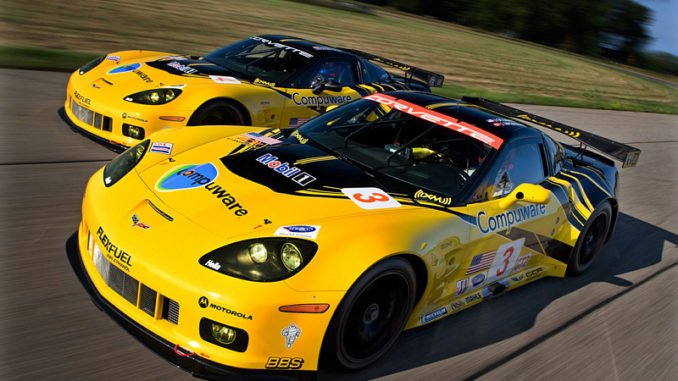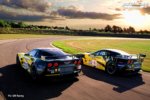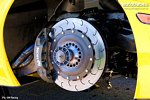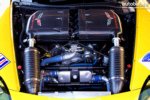
| Corvette Racing will open a new chapter with the competition debut of the next-generation Corvette C6.R at the Mid-Ohio Sports Car Course on August 6-8. In anticipation of a single GT class in 2010, Corvette Racing will test and develop the latest Corvette C6.R in the GT2 category in the final five rounds of the 2009 American Le Mans Series. With the upcoming move to a unified GT category, the twin Compuware Corvette C6.R race cars will compete against rivals representing Ferrari, Porsche, BMW, Aston Martin, Jaguar, Viper, Panoz, and Ford.Based on the Corvette ZR1 supercar, the next-generation Corvette C6.R has even stronger links to the production version of America’s performance icon than its predecessors. The GT2 rules require the use of many production-based components, expanding the opportunities for the two-way transfer of technology between the race track and the showroom. The updated Corvette C6.R utilizes the ZR1’s body design, aerodynamic package, aluminum frame and chassis structure, steering system, windshield, and other components. The race team has prepared the cars for the rigors of endurance racing with safety and performance modifications as permitted by the GT2 rules.
“One of the many benefits of the Corvette Racing program has been the opportunity to demonstrate the technology transfer between the race car and the production car,” said Mark Kent, GM Racing manager. “The global movement toward a single GT class will allow us to compete head-to-head with more marketplace competitors while increasing both the production content of the Corvette C6.R race cars and the relevance of racing to our customers. This is a step that positions Corvette for the future of production-based sports car racing worldwide, and a move that is perfectly aligned with GM’s marketing and business objectives in racing.” Previous versions of the Corvette C5-R and C6.R race cars have dominated the GTS and GT1 categories in the last decade, winning 77 races and eight consecutive ALMS championships. The GT1 Corvettes were retired following Corvette Racing’s sixth victory in the 24 Hours of Le Mans on June 14, 2009. “In our decade in GT1, our primary focus has been on racing victories and the validation of the Corvette as a world-class sports car,” said Tadge Juechter, Corvette chief engineer. “As an authentic way to communicate to knowledgeable customers, nothing beats racing. As a cost-effective means to improve vehicle performance, nothing beats racing. These are the reasons racing is in Corvette’s DNA. “Behind the scenes, the race team and the production car team have grown closer together, finding numerous ways to support each other and to make both cars better,” Juechter said. “Most automotive companies give lip service to claims like ‘racing improves the breed’ or ‘race on Sunday, sell on Monday’. For team Corvette, it is a daily reality. It is now impossible to imagine one team without the other.” The upcoming GT regulations required a comprehensive redesign of the Corvette C6.R package. In place of the GT1 Corvette’s steel frame, the GT2 version utilizes the production ZR1’s hydroformed aluminum frame as the foundation for a fully integrated tubular steel safety cage. The GT1 version’s wide, louvered fenders are replaced by production-based ZR1 fenders with wheel flares. In accordance with the aerodynamic regulations, the rear wing is reduced 25 percent in width, the diffuser is a flat panel without fences or strakes, and the splitter extends only as far as its production ZR1 counterpart. Steel brake rotors have replaced the carbon discs used previously, and the wheels are aluminum instead of magnesium. The adjustable steering column and steering rack are sourced from the street Corvette. “Integrating a steel safety cage that meets GM Racing’s stringent standards as well as the strength and durability targets required in racing is a challenge with an aluminum frame,” explained Corvette Racing engineering director Doug Louth. “Working in conjunction with the structure and chassis engineers in the Corvette production group, we designed, built and tested numerous examples before we finalized the configuration. We went through a similar process with the production Corvette group on the body design and aero components. It was truly a collaborative effort between the production engineers and the race team.” In the remaining races in 2009, the Corvette race cars will be powered by 6.0-liter GM small-block V8s that are based on the 7.0-liter LS7.R that powered the GT1 version. This reduction in displacement was achieved by shortening the crankshaft stroke from 3.875-inch to 3.32-inch. The diameter of the series-mandated intake air restrictors was decreased from 30.6 mm to 28.6 mm, with a corresponding reduction in engine output from 590 to 470 horsepower. A 5.5-liter production-based GM small-block V8 is currently under development and will be introduced at the start of the 2010 season. The Corvette Racing team is continuing its commitment to green racing with the use of E85R ethanol racing fuel. While much of the hardware has changed, Corvette Racing’s roster of championship-winning drivers remains the same. Johnny O’Connell and Jan Magnussen will share the No. 3 Compuware Corvette C6.R, and Oliver Gavin and Olivier Beretta will drive the No. 4 Compuware Corvette C6. R. They will be joined by Antonio Garcia and Marcel Fassler at Petit Le Mans. Corvette Racing also has the continued support of its long-time sponsors and technical partners. Compuware is the team’s primary sponsor, with Mobil 1 supplying low-friction lubricants and Michelin providing its world-class racing tires. Corvette Racing’s sponsors also include XM Satellite Radio, UAW-GM, Genuine Corvette Accessories, Bose, Motorola, PRS Guitars, and BBS. “Compuware leads the world in application performance solutions, and partnering with Corvette Racing gives us another high-tech, high-performance and high-impact platform for communicating to our customers and prospects,” said Compuware Chairman and CEO Peter Karmanos, Jr. “The launch of the Corvette C6.R in GT2 is a great extension to our relationship with General Motors, Chevy and Corvette. We look forward to even more victories in the months ahead.” The GT2-spec Corvettes were designed, built and tested on a compressed schedule. The program was approved and announced in September 2008, and construction of the first chassis began in early December. The first track test was conducted at Road Atlanta on April 8-9, followed by single-car tests in Elkhart Lake, Wis., and Sebring, Fla. “The Corvette Racing team had to take on several challenges simultaneously to execute this program,” said Doug Fehan, Corvette Racing program manager. “We were preparing for our regular race season with the GT1 cars while designing the GT2 version. The cars were being built and tested in the midst of our preparations for Le Mans. The team was multi-tasking to the extreme, operating on a leaner budget and a faster timeline. It was a monumental effort to have these cars ready for the Mid-Ohio race.” Advanced technology tools enabled Corvette Racing to meet the challenge. “With the short development schedule, we relied on ‘virtual’ design and computer simulation more than ever before,” said team manager Gary Pratt. “We made design, engineering and manufacturing simultaneous processes as much as possible. For example, while the first chassis was being built, we continued to run computer simulations on suspension geometry and refined the aerodynamics using CFD (computational fluid dynamics) because these areas didn’t have to be finalized until later in the production timeline. We have developed the capabilities to do finite element analysis and composite fabrication in-house, which has accelerated our design and production cycle. “We’re not running for a championship this year, so we’re looking at the upcoming races as preparation for 2010,” Pratt said. “Our only testing from this point on will be at the races, and we’ll be doing it in the public eye. Certainly we hope to achieve the same level of success that we did in GT1, but the caliber of the competition we will face in GT2 is very high. When we started in GT1 in 1999, it took a while to win; now we have 10 years of experience that should help us to become competitive in a new category. Everyone at Corvette Racing is looking forward to the challenge.” Fehan is confident but cautious about Corvette Racing’s prospects in the GT2 category: “In the limited testing we’ve done so far, we’ve been very impressed with the car’s durability, reliability and performance,” he said. “We’ll continue to focus on those three factors in the upcoming races. We view the rest of this year as a development cycle, and we believe that our experience as a team in preparation, race strategy, and pit stop execution should allow us to be competitive even if there is a slight performance disparity.” The GT2 version of the Corvette C6.R will make its debut in the Acura Sports Car Challenge at the Mid-Ohio Sports Car Course in Lexington, Ohio. The two-hour, 45-minute race is scheduled to start at 3 p.m. EDT on Saturday, August 8. ABC will televise the race tape-delayed at 2:30 p.m. EDT on Sunday, August 9. |
-*-*-*-*-*-*-*-
|









Could you write about Physics so I can pass Science class?
Sure thing ! Air is drawn through the carburetor by the vacuum running through the manifold. At the same time, fuel is pumped through the jets to mix with the air in the belly of the engine where it combines with a single tiny spark from the spark plug firing in the cylinder, to produce a controlled explosion ! This explosion is called combustion and pushes the piston in the cylinder up and down. The up and down movement creates air compression that is pushed through the extractors and out the exhausts thereby turning that air pressure into power. On more modern vehicles, the carburetor is replaced with a computer that calculates and regulates the required air to fuel mixture ratio to produce more power. In either system, this power is transferred to the rear wheels via the differential which is spun by the axle which is of course spun by the centripetal force generated by the gear box. As the basic law governing all Physics on Earth is Gravity, this power transfer to the road effectively pushes the car away. This is Newtons first law in action; “each action has an equal and opposite reaction”, and touches also on his third law; “what goes up, must come down” when defining the operation of the cylinders. Since Force = Mass multiplied by the Acceleration, we can calculate any variable of this mass in motion and determine the power required to meet the desired acceleration. The car is one of man’s greatest creations and one of the best example of harnessing Physics ! I hope you pass your exam !!
These were glory race days for Corvette. Hopefully the knew one can keep up the tradition.
I’ve always loved the Corvette! This one is amazing!
Hi to all, I think every one is getting more from this website, and your views are pleasant in support of new visitors.
The race versions of any car series are always the best looking. This is especially true for for the C6R
This text is invaluable. How can I find out more?
Hello, I wish for to subscribe for most recent updates, so where can i do it please ?
Kris, check the RSS feeds at the top right of the page, or subscribe free at the login and subscribe prompts in the right hand column.
Spot on with this write-up, I absolutely think this amazing site needs a great deal more attention from the world.
Looks great. thanks again.